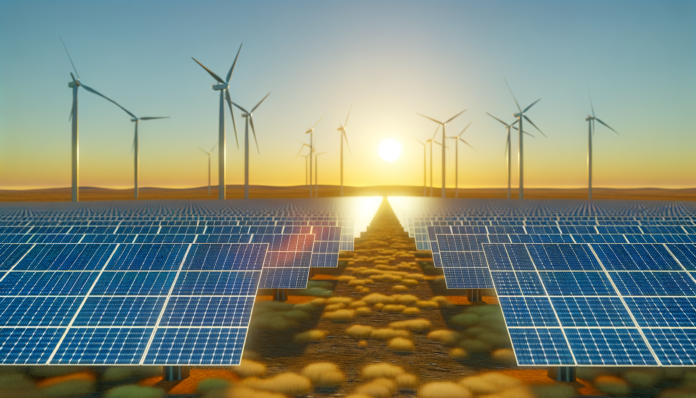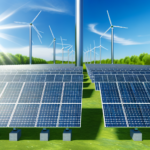Introduction
Overview of Solar Energy
Solar energy, derived from the sun’s radiation, is one of the most abundant and sustainable sources of energy available to us. It can be harnessed using various technologies, with solar panels being the most common method. These panels convert sunlight directly into electricity through the photovoltaic effect, providing a clean and renewable energy source. As the world grapples with the challenges of climate change and the depletion of fossil fuels, solar energy has emerged as a crucial component of the global energy mix.
Importance of Solar Panel Efficiency
The efficiency of solar panels is a critical factor in determining their viability and effectiveness. Efficiency refers to the percentage of sunlight that a solar panel can convert into usable electricity. Higher efficiency means more energy can be generated from a given amount of sunlight, making solar panels more cost-effective and practical for widespread use. Improving solar panel efficiency is essential for several reasons:
- Maximizing Energy Output: Higher efficiency panels generate more electricity, reducing the need for additional panels and space.
- Cost Reduction: Efficient panels lower the overall cost of solar energy systems by reducing installation and maintenance expenses.
- Environmental Impact: More efficient panels contribute to a greater reduction in greenhouse gas emissions by displacing fossil fuel-based energy sources.
- Broader Applications: Enhanced efficiency makes solar panels more suitable for various applications, including residential, commercial, and industrial uses.
Purpose of the Article
The purpose of this article is to explore the latest advancements in solar panel technology that are pushing the boundaries of efficiency and transforming the solar energy landscape. We will delve into the historical evolution of solar panels, highlighting key milestones and current state-of-the-art technologies. Additionally, we will examine groundbreaking innovations in photovoltaic materials, design, and integration with smart technologies that are driving efficiency improvements. The article will also discuss practical applications for outdoor enthusiasts, environmental and economic benefits, and the challenges and future directions of solar panel technology. By providing a comprehensive overview, this article aims to inform and inspire readers about the potential of solar energy and the importance of adopting sustainable practices for a greener future.
The Evolution of Solar Panel Technology
Early Developments
The journey of solar panel technology began in the early 19th century with the discovery of the photovoltaic effect by French physicist Alexandre Edmond Becquerel in 1839. This phenomenon, where light is converted into electricity, laid the groundwork for future innovations. However, it wasn’t until 1954 that Bell Labs created the first practical silicon solar cell, achieving an efficiency of about 6%. These early solar cells were primarily used in space applications, powering satellites and other spacecraft.
Milestones in Solar Panel Efficiency
The efficiency of solar panels has seen significant improvements over the decades. In the 1970s, the oil crisis spurred interest in alternative energy sources, leading to increased research and development in solar technology. By the 1980s, solar panels had achieved efficiencies of around 14%, making them more viable for terrestrial applications.
The 1990s and early 2000s saw the advent of thin-film solar cells, which offered a cheaper and more flexible alternative to traditional silicon panels. These cells, made from materials like cadmium telluride (CdTe) and copper indium gallium selenide (CIGS), achieved efficiencies of around 10-12%. Meanwhile, silicon-based panels continued to improve, reaching efficiencies of 20% by the early 2010s.
Current State of Solar Technology
Today, solar panel technology is more advanced and diverse than ever. The most common type of solar panel remains the crystalline silicon panel, which now boasts efficiencies of up to 22-23%. However, several emerging technologies are pushing the boundaries of what is possible.
**Perovskite solar cells** are one of the most promising advancements. These cells have achieved efficiencies close to 30% in laboratory settings and are praised for their low production costs and versatility. Researchers are working to overcome challenges related to their stability and scalability, with commercial-grade perovskite cells expected to enter the market soon.
**Bifacial solar panels** are another innovation gaining traction. These panels can capture sunlight from both sides, significantly increasing energy production, especially in environments with high albedo surfaces like snow or sand. This technology is particularly effective for large-scale solar farms.
**Floating solar farms**, or floatovoltaics, represent a novel approach to maximizing space and efficiency. By placing solar panels on bodies of water, these installations benefit from the cooling effect of water, which enhances performance and longevity. They also reduce water evaporation and algae growth, providing additional environmental benefits.
**Solar skins** and **transparent solar panels** are making solar technology more aesthetically pleasing and versatile. Solar skins can be designed to match traditional building materials, while transparent panels can be integrated into windows and skylights, generating electricity without obstructing natural light.
In summary, the evolution of solar panel technology has been marked by continuous improvements in efficiency, cost, and versatility. From the early days of silicon cells to the cutting-edge advancements of today, solar technology is poised to play a crucial role in the global transition to sustainable energy.
Breakthroughs in Solar Panel Efficiency
Advanced Photovoltaic Materials
The development of advanced photovoltaic materials has been a game-changer in the quest for higher solar panel efficiency. One of the most promising materials is **perovskite**, which has shown remarkable potential. Researchers at the University of Oxford have developed an ultra-thin perovskite material that boasts a 27% energy conversion efficiency, significantly higher than the 23% efficiency of most commercially available silicon-based panels. This material is not only more efficient but also cheaper to produce, making it a viable alternative to traditional silicon panels.
Perovskite solar cells (PSCs) have seen rapid advancements, with efficiency rates skyrocketing from around 6% to over 27% in just five years. The Oxford team believes that with further development, these cells could achieve efficiencies exceeding 45%. The versatility of perovskite materials allows for their integration into flexible and lightweight solar cells, which can be applied to various surfaces, from rooftops to portable devices. This innovation could revolutionize the solar industry by making solar energy more accessible and affordable.
Innovative Design and Engineering
Innovative design and engineering have also played a crucial role in enhancing solar panel efficiency. One notable advancement is the development of **bifacial solar panels**, which can capture sunlight from both sides. This design significantly increases energy production, especially in environments with high albedo surfaces like snow-covered or sandy areas. Bifacial panels are not only more efficient but also more durable, reducing maintenance costs over time.
Another groundbreaking innovation is the concept of **floating solar farms** or floatovoltaics. By placing solar panels on bodies of water, such as reservoirs and lakes, this technology maximizes space utilization and improves energy efficiency. The cooling effect of water enhances the performance and longevity of the panels, while also reducing water evaporation and algae growth. This approach is particularly beneficial in regions with limited land availability for solar installations.
Integration with Smart Technologies
The integration of smart technologies with solar panels has further pushed the boundaries of efficiency and functionality. **Smart solar panels** equipped with sensors and IoT (Internet of Things) capabilities can monitor and optimize their performance in real-time. These panels can adjust their orientation to capture the maximum amount of sunlight throughout the day, significantly boosting their efficiency.
Moreover, the use of **artificial intelligence (AI)** in solar energy systems has led to smarter energy management. AI algorithms can analyze data from solar panels to predict energy production and consumption patterns, allowing for more efficient energy distribution and storage. This is particularly useful in managing the intermittency of solar power, ensuring a stable and reliable energy supply.
In addition, the development of **transparent solar panels** has opened up new possibilities for integrating solar technology into urban environments. These panels can be used in windows, skylights, and other transparent surfaces, generating electricity without obstructing natural light. This innovation could lead to the creation of self-sustaining buildings, significantly reducing their reliance on external energy sources.
In conclusion, the advancements in advanced photovoltaic materials, innovative design and engineering, and the integration with smart technologies are driving significant improvements in solar panel efficiency. These breakthroughs are not only making solar energy more efficient but also more versatile and accessible, paving the way for a sustainable energy future.
Practical Applications for Outdoor Enthusiasts
Portable Solar Panels for Camping and Hiking
For outdoor enthusiasts, portable solar panels have become indispensable. These lightweight, compact, and efficient devices allow campers and hikers to harness the sun’s energy to power essential gadgets such as GPS devices, smartphones, and portable lights. **Portable solar panels** are designed to be rugged and weather-resistant, making them ideal for the unpredictable conditions often encountered in the wilderness. They can be easily attached to backpacks or tents, ensuring that adventurers have a reliable power source wherever they go. The convenience and sustainability of portable solar panels make them a must-have for anyone looking to explore the great outdoors without compromising on modern conveniences.
Solar Solutions for Boating and RVs
Solar technology has also made significant inroads into the boating and RV communities. **Solar panels for boats and RVs** provide a sustainable and efficient way to generate electricity while on the move. For boaters, solar panels can power navigation systems, lights, and other onboard electronics, reducing the reliance on noisy and polluting generators. Similarly, RV owners can use solar panels to run appliances, charge batteries, and maintain a comfortable living environment without needing to hook up to external power sources. These solar solutions not only enhance the freedom and flexibility of travel but also contribute to a greener and more eco-friendly lifestyle.
Off-Grid Living and Emergency Preparedness
For those who prefer off-grid living or want to be prepared for emergencies, solar panels offer a reliable and sustainable energy solution. **Off-grid solar systems** can power entire homes, providing electricity for lighting, heating, cooling, and running appliances. These systems are particularly valuable in remote areas where access to the traditional power grid is limited or non-existent. Additionally, solar panels are an essential component of emergency preparedness kits. In the event of natural disasters or power outages, solar panels can ensure that critical devices such as communication equipment, medical devices, and refrigeration units remain operational. The ability to generate power independently of the grid provides peace of mind and enhances resilience in the face of unforeseen events.
In conclusion, the advancements in solar panel technology have opened up a world of possibilities for outdoor enthusiasts. Whether it’s for camping, boating, RVing, off-grid living, or emergency preparedness, solar panels offer a sustainable, efficient, and reliable source of energy that enhances the outdoor experience while promoting environmental stewardship.
Environmental and Economic Benefits
Reducing Carbon Footprint
Solar panels play a crucial role in reducing the global carbon footprint. By harnessing the sun’s energy, solar panels generate electricity without emitting greenhouse gases. This is a significant advantage over traditional fossil fuels, which release large amounts of carbon dioxide and other pollutants into the atmosphere. The adoption of solar energy helps mitigate climate change by decreasing the reliance on coal, oil, and natural gas, which are major contributors to global warming.
Moreover, the production and installation of solar panels have a relatively low environmental impact compared to the extraction and burning of fossil fuels. As solar technology advances, the efficiency of solar panels continues to improve, allowing for greater energy production with less environmental impact. This shift towards cleaner energy sources is essential for achieving global sustainability goals and protecting the planet for future generations.
Long-Term Cost Savings
Investing in solar panels offers substantial long-term cost savings for both individuals and businesses. Although the initial installation cost can be high, the return on investment is significant over time. Solar panels reduce or even eliminate electricity bills, depending on the system’s size and local energy rates. In many regions, excess energy produced by solar panels can be sold back to the grid, providing an additional income stream.
Government incentives and subsidies further enhance the economic benefits of solar energy. Many countries offer tax credits, rebates, and other financial incentives to encourage the adoption of solar technology. These incentives can significantly reduce the upfront costs and shorten the payback period for solar panel installations.
Additionally, solar panels require minimal maintenance and have a long lifespan, often exceeding 25 years. This durability ensures that the initial investment continues to pay off for decades, providing a reliable and cost-effective energy solution. As energy prices continue to rise, the financial benefits of solar energy become even more pronounced, making it a smart economic choice for homeowners and businesses alike.
Supporting Sustainable Practices
The adoption of solar panels supports broader sustainable practices and promotes a culture of environmental responsibility. By choosing solar energy, individuals and organizations contribute to the reduction of harmful emissions and the conservation of natural resources. This shift towards renewable energy sources is a critical component of sustainable development and helps create a more resilient and eco-friendly energy infrastructure.
Solar energy also supports sustainable practices in various industries. For example, agrivoltaics, the integration of solar panels with agricultural activities, allows for dual land use, optimizing both energy production and crop growth. This innovative approach not only increases the efficiency of land use but also provides additional income for farmers, promoting economic sustainability.
Furthermore, the growth of the solar industry creates jobs and stimulates economic development. The manufacturing, installation, and maintenance of solar panels generate employment opportunities and drive technological innovation. This economic activity supports local communities and contributes to a more sustainable and diversified economy.
In conclusion, the environmental and economic benefits of solar panels are substantial. By reducing carbon footprints, offering long-term cost savings, and supporting sustainable practices, solar energy is a key driver in the transition towards a more sustainable and resilient future. Embracing solar technology is not only an investment in clean energy but also a commitment to protecting the planet and promoting economic prosperity.
Challenges and Future Directions
Current Limitations
Despite the remarkable advancements in solar panel technology, several limitations still hinder their widespread adoption and optimal performance. One of the primary challenges is the efficiency of energy conversion. While modern solar panels have achieved significant improvements, the average efficiency of commercial panels remains around 20-22%. This means that a substantial portion of the sunlight that hits the panels is not converted into usable electricity.
Another limitation is the high initial cost of installation. Although the long-term savings and environmental benefits are substantial, the upfront investment can be prohibitive for many individuals and businesses. Additionally, the production of solar panels involves the use of rare and sometimes toxic materials, raising concerns about the environmental impact of their manufacturing and disposal.
The intermittency of solar power is another significant challenge. Solar panels generate electricity only when the sun is shining, which means that energy storage solutions are necessary to provide a consistent power supply. Current battery technologies, while improving, are still expensive and have limitations in terms of capacity and lifespan.
Ongoing Research and Development
To address these limitations, extensive research and development efforts are underway. One of the most promising areas of research is the development of new photovoltaic materials. Perovskite solar cells, for example, have shown potential to surpass traditional silicon-based cells in efficiency and cost-effectiveness. Researchers are working to improve the stability and scalability of these materials, with the goal of bringing commercial-grade perovskite solar cells to market in the near future.
Innovations in design and engineering are also playing a crucial role. Bifacial solar panels, which can capture sunlight from both sides, are being optimized for various environments to maximize energy production. Floating solar farms, which place panels on bodies of water, are being developed to address land scarcity and improve efficiency through the cooling effect of water.
Energy storage solutions are another critical focus area. Advances in battery technology, such as solid-state batteries and flow batteries, promise higher energy density, longer lifespans, and improved safety. These innovations could significantly enhance the reliability and affordability of solar power systems.
Predictions for the Future
Looking ahead, the future of solar panel efficiency appears bright. By 2025, we can expect several groundbreaking technologies to become mainstream. Perovskite solar cells are likely to achieve commercial viability, offering a more efficient and cost-effective alternative to silicon-based panels. Bifacial panels and floating solar farms will see wider adoption, particularly in large-scale installations.
Energy storage solutions will continue to evolve, with solid-state and flow batteries becoming more prevalent. These advancements will help mitigate the intermittency of solar power, making it a more reliable energy source. Additionally, the integration of smart technologies, such as the Internet of Things (IoT) and artificial intelligence (AI), will optimize the performance and maintenance of solar power systems.
In the long term, we may see the development of transparent solar panels that can be integrated into windows and other transparent surfaces, revolutionizing urban energy generation. Solar-powered hydrogen production could also become a reality, providing a clean and renewable fuel source that addresses the storage and transportation challenges of solar energy.
In conclusion, while current limitations pose challenges, ongoing research and development efforts are paving the way for a future where solar panel efficiency is significantly enhanced. These advancements will not only make solar energy more accessible and affordable but also play a crucial role in the global transition to sustainable energy.
Conclusion
Summary of Key Points
In this article, we have explored the remarkable advancements in solar panel technology that are revolutionizing the renewable energy landscape. From the early developments of silicon-based solar cells to the latest innovations like perovskite solar cells, bifacial panels, and transparent solar panels, the solar industry has made significant strides in improving efficiency and accessibility. We also delved into practical applications for outdoor enthusiasts, highlighting portable solar panels for camping, solar solutions for boating and RVs, and off-grid living. Additionally, we discussed the environmental and economic benefits of solar energy, including reducing carbon footprints, long-term cost savings, and supporting sustainable practices. Finally, we examined the challenges and future directions of solar technology, emphasizing ongoing research and development and predicting future trends.
The Future of Solar Panel Efficiency
The future of solar panel efficiency looks incredibly promising. Emerging technologies such as perovskite solar cells are expected to surpass traditional silicon-based cells in efficiency and cost-effectiveness. Innovations like bifacial panels, which capture sunlight from both sides, and transparent solar panels, which can be integrated into windows and other surfaces, are set to expand the applications of solar energy. Furthermore, advancements in energy storage solutions and smart technologies will enhance the reliability and integration of solar power into our daily lives. As research and development continue, we can anticipate even greater efficiencies and new breakthroughs that will make solar energy more accessible and affordable for everyone.
Call to Action for Sustainable Living
As we stand on the brink of a solar energy revolution, it is crucial for individuals, businesses, and governments to embrace these advancements and integrate solar technology into their energy strategies. By adopting solar panels for homes, businesses, and public infrastructure, we can significantly reduce our carbon footprint and contribute to a more sustainable future. Investing in solar energy not only offers long-term cost savings but also supports the global transition to renewable energy sources. Let us take action today by exploring solar solutions, advocating for supportive policies, and making conscious choices that promote sustainable living. Together, we can harness the power of the sun to create a cleaner, greener world for future generations.






